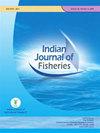糊状饲料中添加日本沙鱼粉对日本鳗鲡生长、饲料效率和消化率的影响
IF 0.3
4区 农林科学
Q4 FISHERIES
引用次数: 0
摘要
本试验以日本沙鱼粉(SFM)替代优质鱼粉(HQFM),并以粘质肠系膜Leuconostoc mesenteroides (VCL)培养液作为黏结剂,对日本鳗鲡(Anguilla japonica)的生长、饲料效率和消化率进行了试验研究。4种试验膏体饲粮分别为:鱼粉与淀粉(F0,对照)、SFM与VCL (F1)、SFM与淀粉与VCL的混合物(F2)、SFM与淀粉(F3)。每种日粮的配制均为等氮和等脂。选取平均初始体重为20±2.5 g的幼鳗,每组10尾,随机分成3组,放入15个鱼缸中,每天投喂2次试验膏体饲料,共投喂90 d。饲喂饲料F2的鳗鲡表现出良好的生长性能(末平均体重;55.3±0.67 g, WGR;169±5%),与对照组(55.5±0.26g, 170±7%)相似(p>0.05)。尽管采用等氮、等脂饲粮,但F1和F3的饲料效率低于其他饲粮,生长性能也有同样的趋势,这可能是由于饲料水稳定性差导致采食量减少所致。应当考虑到,纳入可持续森林管理可能导致诸如磷等不良物质排放到水环境中,尽管它有助于降低生产成本。因此,需要进一步的研究来提高SFM的质量。关键词:替代鱼粉,生长性能,等脂饲料,等氮饲料,肠系膜白孔鱼,水稳定性本文章由计算机程序翻译,如有差异,请以英文原文为准。
Effect of Japanese sandfish (Arctoscopus japonicus) meal in paste diet for Anguilla japonica in terms of growth, feed efficiency and digestibility
In this study, the effect of replacement of high-quality fish meal (HQFM) with Japanese sandfish (Arctoscopus japonicus) meal (SFM) and the utility of a viscous culture broth of Leuconostoc mesenteroides (VCL) as binding material in paste diet for Japanese eel (Anguilla japonica) was tested in terms of growth, feed efficiency and digestibility. Four experimental paste diets contained, fish meal and binding materials as, HQFM and starch (F0, control), SFM and VCL (F1), SFM and a mixture of starch and VCL (F2) and SFM and starch (F3). Each diet was formulated to be iso-nitrogenous and iso-lipidic. Each group of 10 juvenile eels with an average initial body weight of 20 ± 2.5 g were randomly distributed into 15 tanks in triplicates and fish were fed twice daily with one of the 4 experimental paste diets for 90 days. Eels fed with diet F2 exhibited good growth performance (final mean weight; 55.3±0.67 g, WGR; 169±5%), being similar to eels (55.5±0.26g, 170±7%) fed a control diet (p>0.05). In spite of iso-nitrogenous and iso-lipidic diets, the feed efficiency of F1 and F3 were inferior to other diets and the same trend was observed in growth performance also, probably due to reduced feed intake owing to poor water stability of the feeds. It should be considered that incorporation of SFM could lead to the discharge of undesirable matters such as phosphorus into the water environment, though it would contribute to lowering production costs.Therefore, further investigations are needed to improve the quality of SFM. Keywords: Fish meal replacement, Growth performance, Iso-lipidic diet, Iso- nitrogenous diet, Leuconostoc mesenteroides, Water stability.
求助全文
通过发布文献求助,成功后即可免费获取论文全文。
去求助
来源期刊

Indian Journal of Fisheries
FISHERIES-
CiteScore
0.90
自引率
20.00%
发文量
0
审稿时长
6-12 weeks
期刊介绍:
Indian Journal of Fisheries is published quarterly by the Indian Council of Agricultural Research (ICAR), New Delhi. Original contributions in the field of Fish and fisheries science are considered for publication in the Journal. The material submitted must be unpublished and not under consideration for publication elsewhere.
Papers based on research which kills or damages any species, regarded as thratened/ endangered by IUCN crieteria or is as such listed in the Red Data Book appropriate to the geographic area concerned, will not be accepted by the Journal, unless the work has clear conservation objectives.
 求助内容:
求助内容: 应助结果提醒方式:
应助结果提醒方式:


